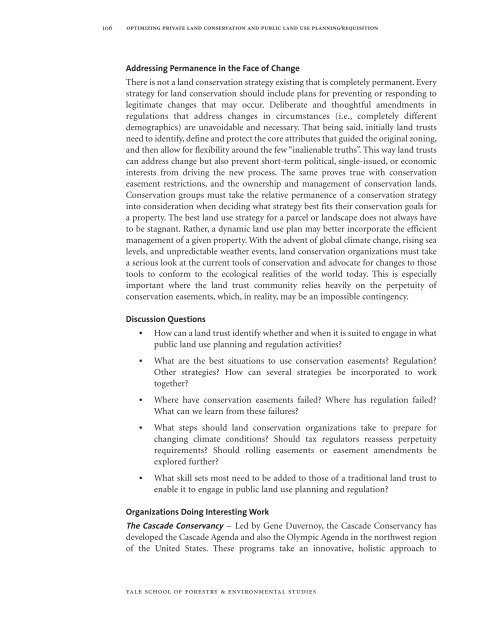Complete Report - Yale University
Complete Report - Yale University
Complete Report - Yale University
Create successful ePaper yourself
Turn your PDF publications into a flip-book with our unique Google optimized e-Paper software.
106OPTIMIZING PRIVATE LAND CONSERVATION AND PUBLIC LAND USE PLANNING⁄REQUISITIONAddressing Permanence in the Face of ChangeThere is not a land conservation strategy existing that is completely permanent. Everystrategy for land conservation should include plans for preventing or responding tolegitimate changes that may occur. Deliberate and thoughtful amendments inregulations that address changes in circumstances (i.e., completely differentdemographics) are unavoidable and necessary. That being said, initially land trustsneed to identify, define and protect the core attributes that guided the original zoning,and then allow for flexibility around the few “inalienable truths”. This way land trustscan address change but also prevent short-term political, single-issued, or economicinterests from driving the new process. The same proves true with conservationeasement restrictions, and the ownership and management of conservation lands.Conservation groups must take the relative permanence of a conservation strategyinto consideration when deciding what strategy best fits their conservation goals fora property. The best land use strategy for a parcel or landscape does not always haveto be stagnant. Rather, a dynamic land use plan may better incorporate the efficientmanagement of a given property. With the advent of global climate change, rising sealevels, and unpredictable weather events, land conservation organizations must takea serious look at the current tools of conservation and advocate for changes to thosetools to conform to the ecological realities of the world today. This is especiallyimportant where the land trust community relies heavily on the perpetuity ofconservation easements, which, in reality, may be an impossible contingency.Discussion Questions●How can a land trust identify whether and when it is suited to engage in whatpublic land use planning and regulation activities?●●●●What are the best situations to use conservation easements? Regulation?Other strategies? How can several strategies be incorporated to worktogether?Where have conservation easements failed? Where has regulation failed?What can we learn from these failures?What steps should land conservation organizations take to prepare forchanging climate conditions? Should tax regulators reassess perpetuityrequirements? Should rolling easements or easement amendments beexplored further?What skill sets most need to be added to those of a traditional land trust toenable it to engage in public land use planning and regulation?Organizations Doing Interesting WorkThe Cascade Conservancy – Led by Gene Duvernoy, the Cascade Conservancy hasdeveloped the Cascade Agenda and also the Olympic Agenda in the northwest regionof the United States. These programs take an innovative, holistic approach toyale school of forestry & environmental studies
















